Minecraft guide: How to turn sugar cane into emeralds with trading
Trading paper for emeralds.

Minecraft has a full trading system in place involving the lively villages strewn about its colorful domains. Using a couple of tricks, you can use this fully-fleshed economy to turn ordinary sugar cane into a bountiful harvest of glittering emeralds, useful to putting back into the community in exchange for rare resources and powerful items. Here's how exactly you can take advantage.
How to grow sugar cane in Minecraft

The first step to turning sugar cane into emeralds in Minecraft is, understandably, actually having sugar cane. Sugar cane is pretty common, and shows up in a wide variety of biomes that are warm to hot in temperature like plains, deserts, jungles and more. All you need is a little bit, and you can quickly build that up into a massive self-sustaining farm just for sugar cane.
The best way to find sugar cane is in a desert, so that's the biome of choice if you have one nearby in your world. Sugar cane always spawns on sand directly adjacent to water and can grow up to four blocks tall. To harvest it, just hit the bottom block of sugar cane with pretty much anything, including your hands, and watch the entire stack cascade down into your inventory. The more you get, the easier it is to build up your farm, but even a single block of sugar cane is enough. While you're at it, go ahead and mine a bunch of sand up as well, since you'll need that too.
Here's everything you need to grow sugar cane:
- Sugar cane. To the surprise of no one, sugar cane is a necessary ingredient in growing sugar cane. Any amount will do.
- Sand. Sugar cane can only grow on sand, so how much sand you have will dictate how large your farm can be.
- A water source. You'll need a nearby source of water. It'll be even easier if you build your own.
- Iron buckets. The final ingredient is a way to transport the water from its original location to its new home in your sugar cane farm.
Once you have everything you need, here's how to grow sugar cane:
- Make sure you have a water source nearby. Anything will do, like an ocean, lake or river. You just need a way to supply water to your farm. If you don't have one, you can build one.

- You can build an infinite water source. To do so, dig a 2x2 hole in the ground (any depth) and use three buckets of water to fill three of the corners with water. You'll notice that the fourth one fills up on its own. Just take water from one corner at a time.
- Decide how big you want your farm to be. You can go as big or as small as you want. A 9x9 square is a very respectable size, and everything will fit quite nicely inside those dimensions.

- Dig out the entire area one block down. This whole area will be replaced in one way or another, so clear it all out.
- Pick a direction. Everything in your farm will be done in rows, and they all need to be facing the same way. If you dug a square, it doesn't really matter. If you built a rectangle, the rows should follow the longer side.

- Start laying sand down. It's important to leave gaps for water. For example, your farm should have a row of sand, a row of water, two rows of sand, a row of water, etcetera until the other side has been reached.
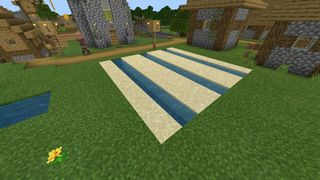
- Start filling in gaps with water. Every single block of sand you intend to have sugar cane on has to be touching a block of water. You simply can't plant sugar cane without it. You'll need to completely fill every empty row with water, which is why the infinite water source helps a lot.
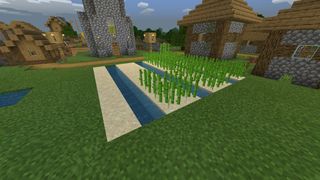
- Start planting the sugar cane. Take the sugar cane you've collected and plant it down one at a time. It doesn't matter if you have enough to fill your whole farm, just that only one block of sugar cane is used in a place at a time. Don't stack them.
- Wait for the sugar cane to grow. Go off and do other Minecraft-y things, build a house, kill some zombies. If you're impatient, you can also use bone meal to accelerate the growth of the sugar cane.
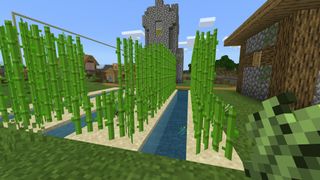
- Harvest the sugar cane. It's essential to only cut down the sugar cane above the roots, and leave one block of sugar cane planted in the ground. This allows the sugar cane to grow again.
- Replant sugar cane in empty spots. If you have any sand left unadorned by sugar cane, use part of your harvest to fill them.
- Repeat, repeat, repeat. The wonderful thing about sugar cane is that once your farm is fully planted, every harvest is pure profit. You don't have to replant your crops or worry about maintenance. Sugar cane is easy, quick, and profitable.
How to turn sugar cane into emeralds in Minecraft

Once you've collected a hefty supply of sugar cane and are confident in the future of your sugar cane farm, it's time to start turning a profit. The key to doing this? Librarians and cartographers. These villagers are one of many currently in Minecraft, but they have an innate desire to hoard as much sugar cane as they possibly can. They also happen to have a pretty much infinite supply of emeralds to trade for it. Here's how to take advantage.
This strategy requires that you live in close proximity to a village of decent size and that you have living, healthy villagers living there. The two most essential villagers for this trick are going to be the librarian and the cartographer, both of which have a specific table that they like to work at. More importantly, there are a few things you'll need to learn how to craft: paper, lecterns, and cartography tables. Honorable mentions go to books and bookshelves.
Get the Windows Central Newsletter
All the latest news, reviews, and guides for Windows and Xbox diehards.
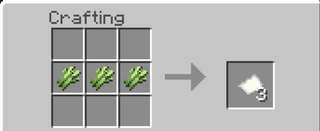
- Paper. Crafted by combining three pieces of sugar cane in a crafting table.

- Lecterns. Crafted by combining one bookshelf and four wooden slabs of any kind in a crafting table.

- Cartography tables. Crafted by combining two pieces of paper and four wooden planks of any kind in a crafting table.

- Books. Crafted by combining three pieces of paper and one piece of leather in a crafting table.

- Bookshelves. Crafted by combining three books and six wooden planks of any kind in a crafting table.
Now that you know how to craft everything, here's a quick break down of each villager:
Librarian

- What table do they use? A lectern.
- What do they want? Paper and books.
- What's the desired level? Apprentice or better.
- What do they look like? Off-white apron with a book worn on the head.
Librarians are the original recipient of any Minecraft player's paper stores. While villagers have changed a lot in both the number of professions and appearance over the years, librarians are still very useful for turning affordable and easily-acquired sugar cane into emeralds. At level one, or Novice level, librarians will trade 24 pieces of paper for an emerald, and this trade can be done 16 times before the librarian is unable to make that trade for a while. The price will also rise the faster you make the trade, but that's what makes sugar cane so special. It grows fast and harvests even faster.
At the Apprentice level, librarians will also trade books for emeralds! Books are a little harder to come by since you need leather as well, but it's a good backup for when you expend your trades for paper. Four books will net you an emerald, and you can repeat this trade up to 12 times! Again, the cost may rise as you move forward, but at this point, you've probably already built up a substantial number of emeralds.
Cartographer
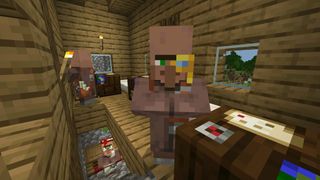
- What table do they use? A cartography table.
- What do they want? Paper.
- What's the desired level? Novice or better.
- What do they look like? Traditional clothing with a brown vest and golden monocle.
Cartographers aren't quite as lucrative as librarians, but they do have the same trade for paper at the novice level: 24 pieces of paper for an emerald, with a 16 trade limit. The issue with the cartographer is that when that trade is expended, there's nothing to fall back on until prices rise again for paper, and you can trade again.
Cartographers do deserve an honorable mention for an alternative trade at the Apprentice level, though, since you can also trade 11 glass panes for an emerald as well. This requires a ready source of sand and the patience to smelt it into glass, then turn that glass into glass panes. It's not as renewable, efficient, or timely, but it's still relatively affordable to do.
Tips and tricks for trading
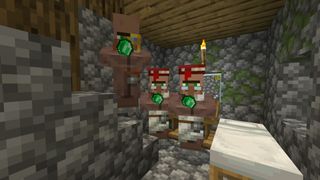
Using librarians and cartographers, you can have a pretty decent income of emeralds to turn around and use on other things. However, Minecraft has a functional economy (even if it's pretty basic) that runs off of supply and demand. If a villager notices that a player is selling a ton of paper, the value of paper will fall, and the cost to trade it for an emerald will rise. If a player stops making that trade, the prices will return to normal. This is calculated by item, so in this scenario, the value of paper would lower across all villagers that trade paper for emeralds.
On top of that, each villager also has a limited number of times they can make a particular trade. If you do a trade too many times, that trade is no longer available and will be crossed out with a red "X" in the villager's trading menu. So not only do players need to be aware of how much they've traded but how much their trades are costing them. The reason using sugar cane is so practical is because it's infinitely renewable, grows reasonably fast, and is a consistently easy trade to find.
This information is usually refreshed about twice a day by villagers. Villagers spend a lot of time wandering around, but they do go to "work" throughout the day and travel to their occupational table. For librarians, it's their lectern. For cartographers, their cartography table. When you notice a villager you've traded with returning to their workstation, that means they're resupplying and are open to trade again. More than that, prices will be altered to reflect the demand for specific trades.
To maximize your trading efficiency, use these tips:
- Alternate trades. When you've noticed that the cost of emeralds for paper is extortionately high everywhere you look, take a break for a little while. Maybe trade some books instead of paper, or spend some of your newly acquired emeralds. After some time, the value of paper will rise again.
- Alternative villagers. If you don't mind the cost of the trade (likely after your farm has matured fully), then having multiple librarians and cartographers you can trade with helps. Go back and forth between villagers to continuously get more emeralds as you go, without having to wait for villagers to restock.
- Breed more villagers. If you don't have enough villagers you want to trade with, you can always breed some more. Just place down more lecterns and cartography tables around your village to improve the chances that new villagers will choose those occupations when they grow up.
- Take breaks. It isn't necessary to hoard as many emeralds as you can all at once. If you trade with your villagers once every couple of days, you'll slowly build up a nice store of emeralds without driving costs up too high.
- Become a hero. This one is optional, but if you save a village from a pillager raid,, you gain the Hero of the Village status for a limited time that reduces prices for trading. If you just need more emeralds, this is a way to save you some dough.
From paper cuts to riches

As long as you follow these tips and tricks, you'll almost certainly become a respected and established merchant in your village. The process of turning sugar cane to emeralds is the most reliable and effective method I've found for maximizing your trading, and you can start it all by finding a single stalk along a river's shore. Forget filling chests with ore that you've mined, how about filling chests with emeralds you got for scraps of paper?
Have you tried this method before? Is there an even better way to trade in Minecraft? Sound off in the comments below!

Zachary Boddy (They / Them) is a Staff Writer for Windows Central, primarily focused on covering the latest news in tech and gaming, the best Xbox and PC games, and the most interesting Windows and Xbox hardware. They have been gaming and writing for most of their life starting with the original Xbox, and started out as a freelancer for Windows Central and its sister sites in 2019. Now a full-fledged Staff Writer, Zachary has expanded from only writing about all things Minecraft to covering practically everything on which Windows Central is an expert, especially when it comes to Microsoft. You can find Zachary on Twitter @BoddyZachary.
